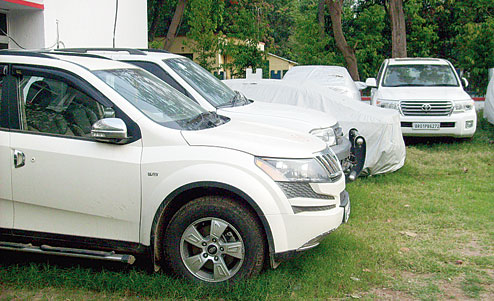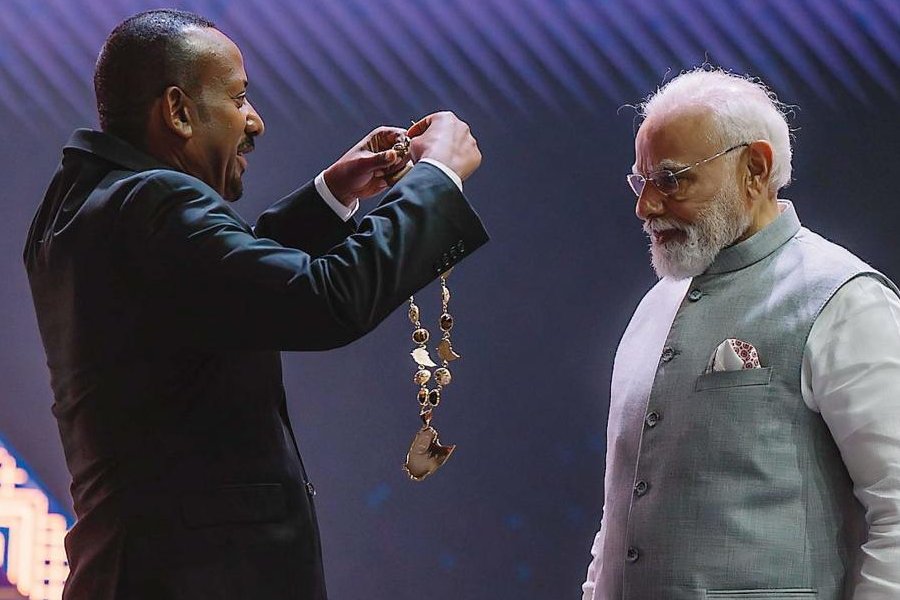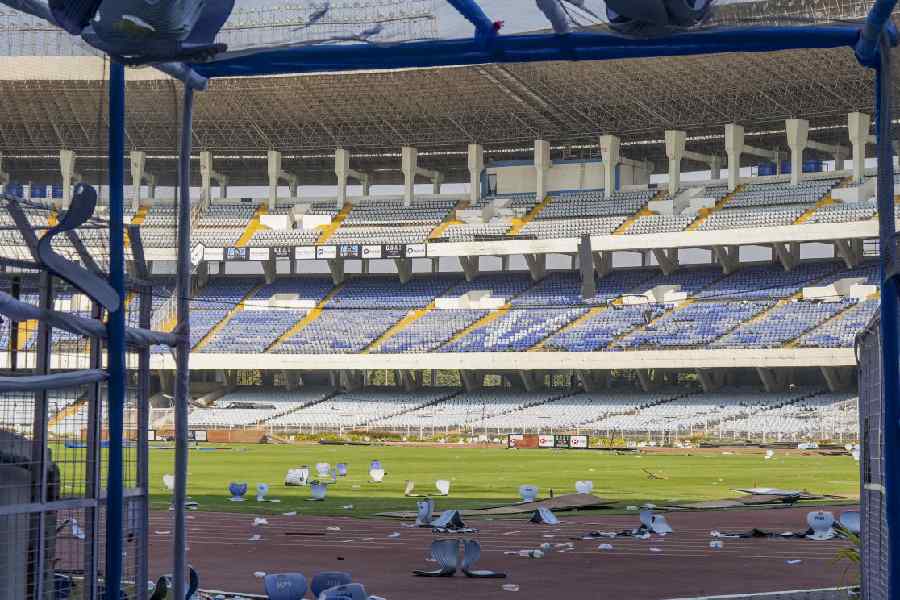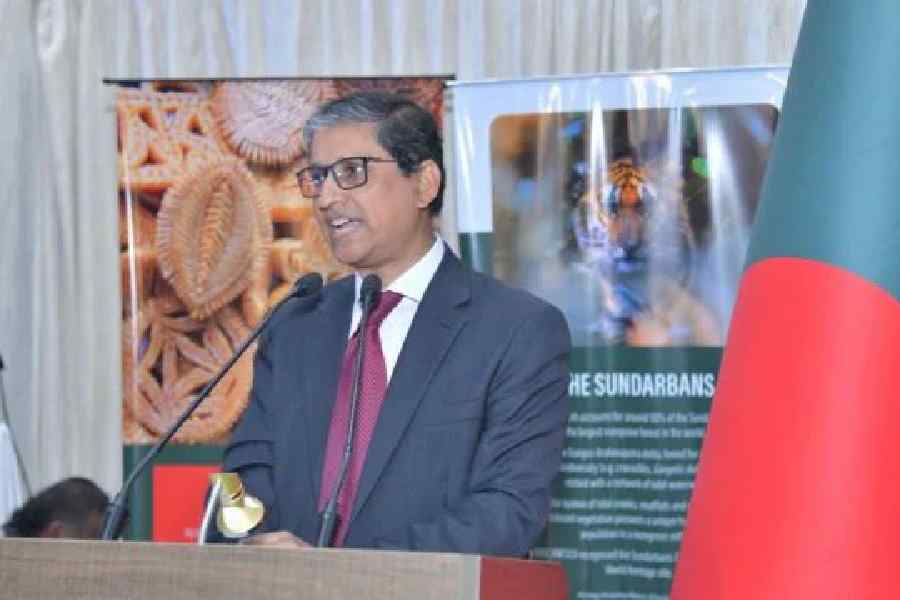 |
| Model act: Cars seized by Bihar police; (below) DGP Abhayanand Pics: Debaashish Bhattacharya |
Bharat Singh is on his way back home after dining out with his family. Being out late at night on the streets in Patna no longer worries the orthopaedic surgeon. The cold barrels of the two pistols held to his head, one on each side, now seem like a distant nightmare.
One late evening in February 2003, when he was driving home with a cousin from a wedding reception, a car blocked his way in the heart of the Bihar capital. Four hooded men leapt out, brandishing pistols. The doctor and his cousin were kidnapped, and a ransom of Rs 5 lakh was demanded from his family. They were finally released without having to pay the ransom.
The abduction was just one of the many that took place in Bihar in those days. “We lived in fear,” Singh recalls “Anybody could be kidnapped then, even in broad daylight. Nobody was spared.”
Ten years on, Singh sees a different scenario. Lalu Prasad’s Rashtriya Janata Dal (RJD) that ruled Bihar has long been ousted by Nitish Kumar’s Janata Dal (United). And the law and order situation in Bihar has undergone a sea change. Kumar had announced this as his priority after he came to power in 2005. And he seems to have delivered.
“The rule of the law has been established for the first time in Bihar,” says Shaibal Gupta of the Patna-based Asian Development Research Institute.
The Bihar police, once the butt of all jokes, are now being hailed. With its 87,000-strong force and an annual budget nudging Rs 4,200 crore, the state police have been making waves. The plunge in organised crimes such as kidnapping and robbery, along with an accompanying high conviction rate, is being discussed across the country — from Jharkhand and Uttar Pradesh to Jammu and Kashmir.
“We should all emulate the Bihar model of crime fighting, applying existing laws and following up cases in court,” says Abdul Ghani Mir, inspector general of police (Kashmir zone).
Mir had been asked by his bosses to find out if the measures taken by Bihar could be emulated by the J&K police. Mir recalls talking to Raveendran Sankaran, a senior IPS officer from Bihar, for a couple of hours one night.
 |
The “Bihar model” was even adopted by the All India Police Science Congress, organised by the Union home ministry’s Bureau of Police Research and Development, in a resolution in its last session in Patna in February.
Indeed, if the figures are to be believed, the model is worth emulating. If the state witnessed 335 kidnappings in 2003, it saw 70 in 2012. The number of murders and robberies has fallen by 13 per cent and 46 per cent since 2006.
The police are also painstakingly following up cases. Some 81,080 criminals have been convicted since 2006. Of them, 13,197 have been sentenced to life imprisonment and another 157 to death by courts in Bihar.
“People are living in peace and everyone wants to know how we have achieved that, given the state’s long history of lawlessness,” says Bihar director general of police Abhayanand (he uses only one name).
Across the country, there is talk of the achievements of the Bihar police. The Jharkhand police have asked the Bihar DGP to send a senior officer to Ranchi so they could “discuss the way Bihar is combating crime”. And the Uttar Pradesh police sent an IPS officer to Bihar recently to study the way its police gathered evidence in criminal cases and followed up trials.
So how did the metamorphosis happen? To reinforce the rule of law, the Nitish Kumar government adopted a three-pronged strategy — making full use of the existing laws, protecting the police from political interference and speeding up judicial processes.
To start with, the police booked armed offenders under the Indian Arms Act which often did not require witnesses in court other than police personnel present during the arrest. Under the act, a criminal arrested with a country-made gun can be jailed for up to three years while one with an unlicensed foreign-made gun can face up to seven years in jail.
“Bihar has demonstrated how to get the criminals convicted swiftly,” says Mir, who also attended the Police Congress in February. “This is what the Indian police lack. We investigate a case well but often don’t do enough when it comes to prosecution and the criminals walk off.”
What has also changed is that in today’s Bihar, the police can do their jobs without political pressure. The police chief adds that the standing instruction from the chief minister (who also holds the home portfolio) is to “maintain law and order at any cost”. Abhayanand adds, “There is absolutely no pressure on us to do anything illegal. We go by the book.”
Junior officers agree. “This is as free as the police can ever get in our democracy,” stresses Rabish Kumar, the sub-divisional police officer of Ara in Bhojpur district.
Helping the police in its clean-up act is the state judiciary. “We assured the government that we would see that trials were not held up for want of magistrates. We also asked the administration to ensure that witnesses, including investigating officials and doctors, turned up in court on schedule,” says a sitting judge of the Patna High Court, speaking on condition of anonymity.
To help the police in their investigations, Patna’s once-rundown forensic laboratory was renovated at a cost of Rs 6 crore in 2012. It now houses a DNA Lab and offers such modern facilities as voice spectrography to identify voices on tapes. The state government has hired some 40 forensic scientists to run the lab.
“Viscera reports would take as long as five years in the old lab. Now we get them instantly,” Abhayanand says.
Another kind of crime — economic crime — is under the scanner as well. Corruption is a serious issue in Bihar, and attempts are on to deal with it.
Using the Criminal Law Amendment Ordinance of 1944 and the Prevention of Money Laundering Act, which allow confiscation of ill-gotten properties of any individual either by the state police or the enforcement directorate, the Bihar police have now registered 42 cases for confiscation of properties, mostly against government officials.
Inspector general of police (economic offences) Praveen Vashista says they have also seized luxury cars including two BMWs and one Land Cruiser from government officials. Corrupt village heads, many of whom are said to have graduated from motorcycles to Boleros over the past few years, are not being spared either, he says.
There is always a flipside to a success story. In this case, there are some who wonder if Bihar is slowly turning into a “police state”. Patna High Court lawyer Yadu Vansh Giri accuses the police of misusing the Arms Act for speedy convictions. “It is the easiest way to send somebody to jail as the court has to go by what the police say, with few independent witnesses ever coming forward,” the criminal lawyer says.
There are others who contend that the dip in organised crime is linked to the fact that gang leaders are now eyeing other sectors for profit. “A lot of money is being spent on building roads and bridges and those engaged in organised crime are now involved in this. You have more money and less risk in construction, so why should you do high-risk crimes like kidnapping,” asks former Bihar DGP Dhruva Prasad Ojha.
But Bharat Singh will have none of it. The memory is searing — and the once-abducted surgeon doesn’t want to relive the “horrors” of those days. “I don’t feel the need to look over my shoulders or watch the car behind me in rear view mirror anymore,” he says.










